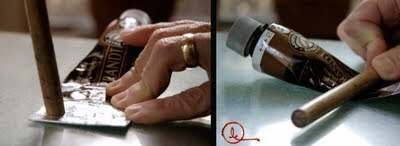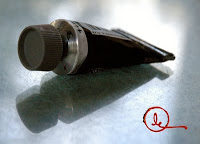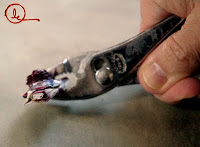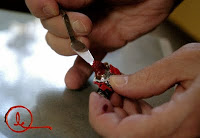Squeezing every penny from a tube of paint
By Al R. Young
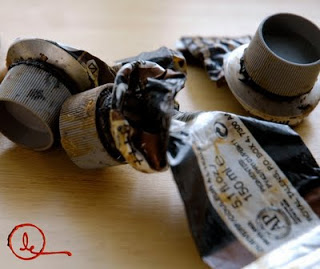 |
Separate his and hers toothpaste tubes have helped many a marriage—there's certainly more than one legitimate way to squeeze a tube and individuality should probably reign supreme. But toothpaste doesn't generally run over two hundred dollars a pop, and something like a really splendiferous cerulean blue can. So what's the best way to skin the oil-paint-tube cat—probably not by wringing it out in utter frustration, as shown at left, and chucking it out with a guilty promise of doing better next time.
A new tube of paint brings back all the grade school joys of a new box of crayons, and, frankly for a while, I just enjoy the sheer luxury of it all, and don't bother with whether the paint in the tube has been uniformly squeezed from the bottom. However, I do find it helpful to avoid wrinkles or crimps in the metal tube.
I keep a short length of 5/8-in. dowel handy for getting as much paint as possible out of oil paint tubes. Since creating art is fundamentally a tactile experience, whether or not a tube of paint is crumpled or pressed may not suit every taste, but at $1.50 per milliliter for some oil paints, the following steps readily stretch a studio budget.
As the tube ages with use, I finally bring out the dowel and use one of its flat ends to press the paint first from a corner of the tube near its folded end and then all along the fold. Then, using the dowel like a rolling pin, I flatten the used end of the tube; moving the paint toward the top of the tube. Once there is enough flattened tube to grasp, I not only roll the dowel across the used portion of the tube, but pull the tube itself beneath the dowel, while holding it flat against the palette or a table top.
For a while, I leave the spent part of the tube flat because it's easy to grasp. Inevitably, however, I start folding the flattened part of the tube toward the cap.
When the rolled part of the tube can no longer be pressed against the paint remaining in the tube, to force it onto the palette, I reach for the pliers that are a much-used piece of studio equipment.
The pliers expel all of the paint, even being used at last to flatten the tube's collar.
And when the collar has been flattened, a small palette knife can be used to scoop out the little bit remaining.
Tags: 2011, Tips and techniques
Browse articles by year: 2025 . 2024 . 2023 . 2022 . 2021 . 2020 . 2019 . 2018 . 2017 . 2016 . 2015 . 2014 . 2013 . 2012 . 2011 . 2010 . 2009 . 2008 . 2007 . 2006 . 2005 . 2004 . 2003 . 2002 . 2001 . 2000 . 1999 . 1998 . 1997 . 1996
Browse articles by topic: Art lessons . BenHaven Archives . Blank art diaries . Fine art photography . Framing . Illustration . Inspiration and creativity . Isles of Rune . Limited Editions Collection . My Fathers Captivity . News . Novellas . Oil paintings and prints . Operations announcements . Orders and shipping . Overview . Portfolios . The Papers of Seymore Wainscott . Project commentaries . Recipes by Nancy Young . Recommended reading . Recommended viewing . Temple artworks . The Storybook Home Journal . Tips and techniques . Tools supplies and operations
Browse articles by topic: Art lessons . BenHaven Archives . Blank art diaries . Fine art photography . Framing . Illustration . Inspiration and creativity . Isles of Rune . Limited Editions Collection . My Fathers Captivity . News . Novellas . Oil paintings and prints . Operations announcements . Orders and shipping . Overview . Portfolios . The Papers of Seymore Wainscott . Project commentaries . Recipes by Nancy Young . Recommended reading . Recommended viewing . Temple artworks . The Storybook Home Journal . Tips and techniques . Tools supplies and operations
